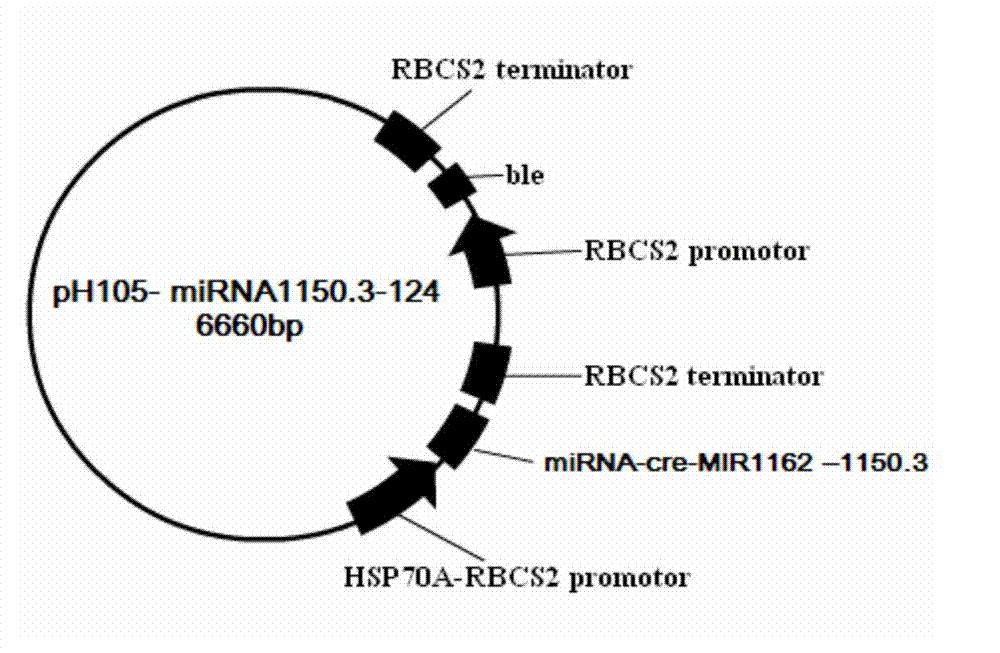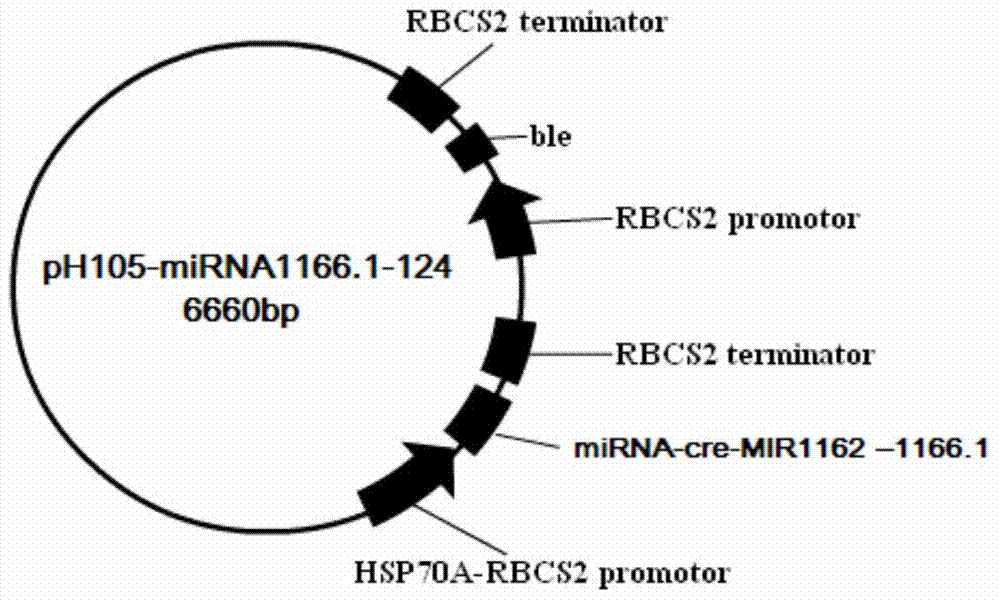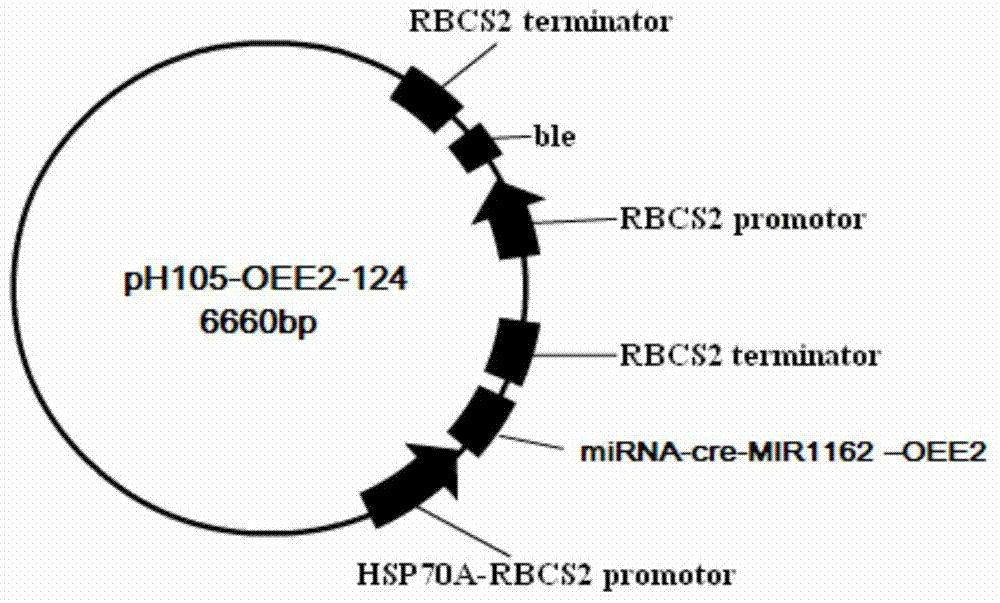Transgenic regulation and control miRNA (micro ribonucleic acid) gene algae capable of realizing continuous photosynthetic hydrogen production and creation method of gene algae
A construction method and gene technology, which are applied in the field of trans-regulated miRNA gene algae and their construction, can solve the problems of no industrial application prospect, decreased growth and hydrogen release capacity, difficulty in separating green algae from culture medium, etc.
- Summary
- Abstract
- Description
- Claims
- Application Information
AI Technical Summary
Problems solved by technology
Method used
Image
Examples
Embodiment 1
[0061] Selection and cultivation of embodiment 1 transgenic recipient algae strain
[0062] The recipients of the transgenic operation selected in the present invention are cell wall-deficient Chlamydomonas reinhardtii (Chlamydomonas reinhardtii, cc-849, purchased from the Chlamydomonas Genetic Center of Duck University, USA) and cytochrome b-deficient Chlamydomonas reinhardtii (cc-2654, purchased from Chlamydomonas Genetics Center, Duck University, USA).
[0063] The culture medium used when the above-mentioned Chlamydomonas reinhardtii was cultivated was TAP medium, and the components of the TAP medium were as follows: Tris2.42g, 4× Beijerinck salts (containing 16g NH per liter 4 Cl, 2g CaCl 2 .2H 2 O,4g MgSO 4 .7H 2 O) 25mL, 1M potassium phosphate buffer 1mL, Trace trace element mixture (containing 11.4g H per liter 3 BO 3 ,5.6g MnCl 2 .4H 2 O,22g ZnSO 4 .7H 2 O, 4.99g FeSO 4 .7H 2 O, 1.61g CoCl 2 .6H 2 O, 1.57g CuSO 4 .5H 2 O,1.1g(NH 4 ) 6 Mo 7 o 24 .4H...
Embodiment 2
[0065] Example 2 Screening or designing regulation miRNAs
[0066] (1) Screening of intracellular miRNAs
[0067] After Chlamydomonas reinhardtii was cultured under sulfur deficiency stress, its hydrogen production increased, the expression of its miRNAs was detected, the miRNAs whose expression changed were counted, and a small RNA library was established (BMC Genomics, 2012, 13:108), and It was found that the expression of Chlamydomonas miRNAs in the established small RNA library changed significantly (more than 2 times), and the expression of most miRNAs was up-regulated, and some predicted target genes were screened from the established small RNA library. They are miRNAs related to photosystem II and whose expression levels are significantly upregulated, such as miRNA909.1, miR1150.3, miR1166.1, miR1158. Figure 9 For the selected miRNAs and their predicted target genes. Here, it is preferable to select miR1150.3 and miR1166.1 for the next step to construct the framework...
Embodiment 3
[0071] Embodiment 3 regulates the construction and synthesis of miRNAs expression backbone
[0072] When miRNAs in green algae are expressed in cells, they first transcribe precursors containing a backbone structure. Therefore, when overexpressing intracellular miRNAs, it is also necessary to select an expression backbone for the designed "regulatory miRNA". In this example, the natural cre-MIR1162MI0006223 with high expression abundance in Chlamydomonas reinhardtii was selected as the backbone precursor of the miRNAs to be screened. The mature sequences of intracellular regulatory miRNAs screened from the small RNA library were replaced with the mature sequences of miRNAs in cre-MIR1162MI0006223 to obtain a complete framework for regulating the expression of miRNAs.
[0073] In this example, miR1150.3 and miR1166.1 were screened from the library for research, and other miRNAs in the library could be constructed and synthesized according to this method. The mature sequences o...
PUM
 Login to View More
Login to View More Abstract
Description
Claims
Application Information
 Login to View More
Login to View More - R&D
- Intellectual Property
- Life Sciences
- Materials
- Tech Scout
- Unparalleled Data Quality
- Higher Quality Content
- 60% Fewer Hallucinations
Browse by: Latest US Patents, China's latest patents, Technical Efficacy Thesaurus, Application Domain, Technology Topic, Popular Technical Reports.
© 2025 PatSnap. All rights reserved.Legal|Privacy policy|Modern Slavery Act Transparency Statement|Sitemap|About US| Contact US: help@patsnap.com



